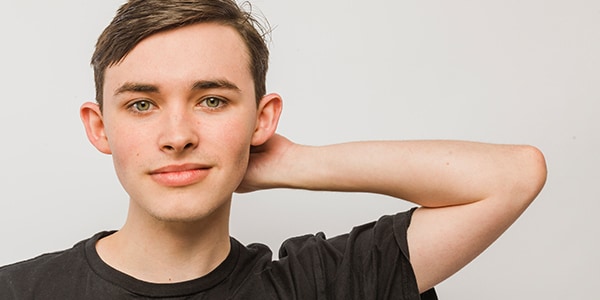Is autism on the rise?
Why the number of kids being diagnosed with autism is increasing.
Health Agenda magazine
October 2017
When their son, Jack (pictured), was diagnosed with autism in 1999, Nicole and Ian Rogerson left the doctor’s office in shock. “We just sat in the car, in the rain, and cried,” Nicole recalls. “All of a sudden we were facing this lifelong diagnosis. Jack was our first child; we were so naive.”
Autism spectrum disorder (ASD) is defined as a neurodevelopmental disorder that affects the way people communicate and interact with others, and how they perceive the world. ASD has wide-ranging levels of severity, varying characteristics and shows up differently in every person. While ASD is often diagnosed around the age of 2, its symptoms may be subtle and a diagnosis can be given at any life stage.
Lacking information about what she could do to help her son, Nicole threw herself into researching autism. As there was nothing else available to her at the time, she spent 20 to 30 hours a week designing and delivering an ad-hoc early intervention program to help Jack with his learning difficulties. Jack, now 21, has just finished an apprenticeship and started a full-time job as a chef.
“I’m very good at my job,” he says, “and the head chef Simon says I’m improving all the time. It’s hard work but I like it.”
Nicole went on to establish Autism Awareness Australia, a not-for-profit advocacy group that facilitates Australia’s largest online community for parents and carers dealing with children on the autism spectrum.

Are autism diagnoses increasing?
The number of autism diagnoses has increased in recent years. The Australian Bureau of Statistics estimates the number of diagnoses has risen to 164,000 in 2015 from 64,400 people in 2009.
However, according to clinical psychologist Professor Adam Guastella of the University of Sydney’s Brain and Mind Research Institute, there’s no evidence that the incidence of the condition is actually rising. He believes the rise in diagnoses is due to better education within the medical field and the availability of treatment and support for people affected by the condition. So kids who would have previously gone undiagnosed are now receiving the early intervention and support they need.
“A reliable diagnosis can now be made in most children at about 18 months,” says Prof Guastella. “Going back 15 years, there was a tendency to delay diagnosis until the physician was absolutely certain, and this would mean that the services and support for the family and child wouldn’t be activated until about 5 or 6 years of age.”
Autism diagnosis methods
The rates of autism are also rising because of changes in the way it’s diagnosed. Currently, this is by measuring a child against known developmental benchmarks. One common assessment method is an ‘Autism Diagnostic Interview – Revised’: an interview between a trained assessor and the primary caregiver. The outcomes are then evaluated with the help of the Diagnostic and Statistical Manual of Mental Disorders – the global benchmark text for psychiatric diagnosis.
A shift in these diagnostic criteria came in 2013, when the 5th edition of the manual was released. The DSM-5, as it’s known, reclassified autism – and potentially changed the diagnosis of thousands of patients.
In the past there were several autism-like conditions listed in the manual, but the new release sought to widen the diagnostic criteria. It introduced a “spectrum”, doing away with the terminology that had previously split autism-like conditions into different classifications such as Asperger’s syndrome and Rett syndrome.
According to Prof Guastella, these changes reflected a need in the health profession to study autism more broadly. “In the past 30 years, there have only been a few studies of over 100 children,” he admits. “If you look at the cancer space, studies of hundreds of people are happening all the time. In autism research, studies often have only 40 participants and, as a result, we’re left with constant confusion about whether a treatment is effective or not.”
This lack of large-scale and ongoing studies means there’s a lack of reliable data that establishes how different treatments affect patients long term.
Acting on symptoms of autism
Nicole Rogerson now encourages parents to act as soon as they can if they suspect their child has autism.
“Don’t let the word scare you; the most important thing is to get on with getting your child some help,” she says. “You really have to get busy teaching them things – and you have to start yesterday. Children with autism can learn – but it’s the work done between [the ages of] 2 and 20 that can make huge impacts on their lives.”
Jack encourages young people diagnosed with ASD to keep positive when possible: “Sometimes things are difficult but you have to stick with it. Keep trying and things get better and better. You only have one life so make the best of it.”
related articles
SUPPORTING A LOVED ONE THROUGH A TOUGH DIAGNOSIS
It’s always distressing when someone you care about gets sick. Here are some strategies for taking care of them, and yourself.
SERIOUS CONDITIONS THAT CAN BE MISSED
Many serious conditions have vague or hidden symptoms. Here’s how to identify and screen for them.
CHILDHOOD VACCINATION: THE FACTS
What you need to do to keep your child on track with the vaccination schedule, and the truth about vaccination side effects.
HOW TO CARE FOR YOUR TEEN’S MENTAL HEALTH
Recognising emotional issues early is the best way to protect your teenager against depression and anxiety.